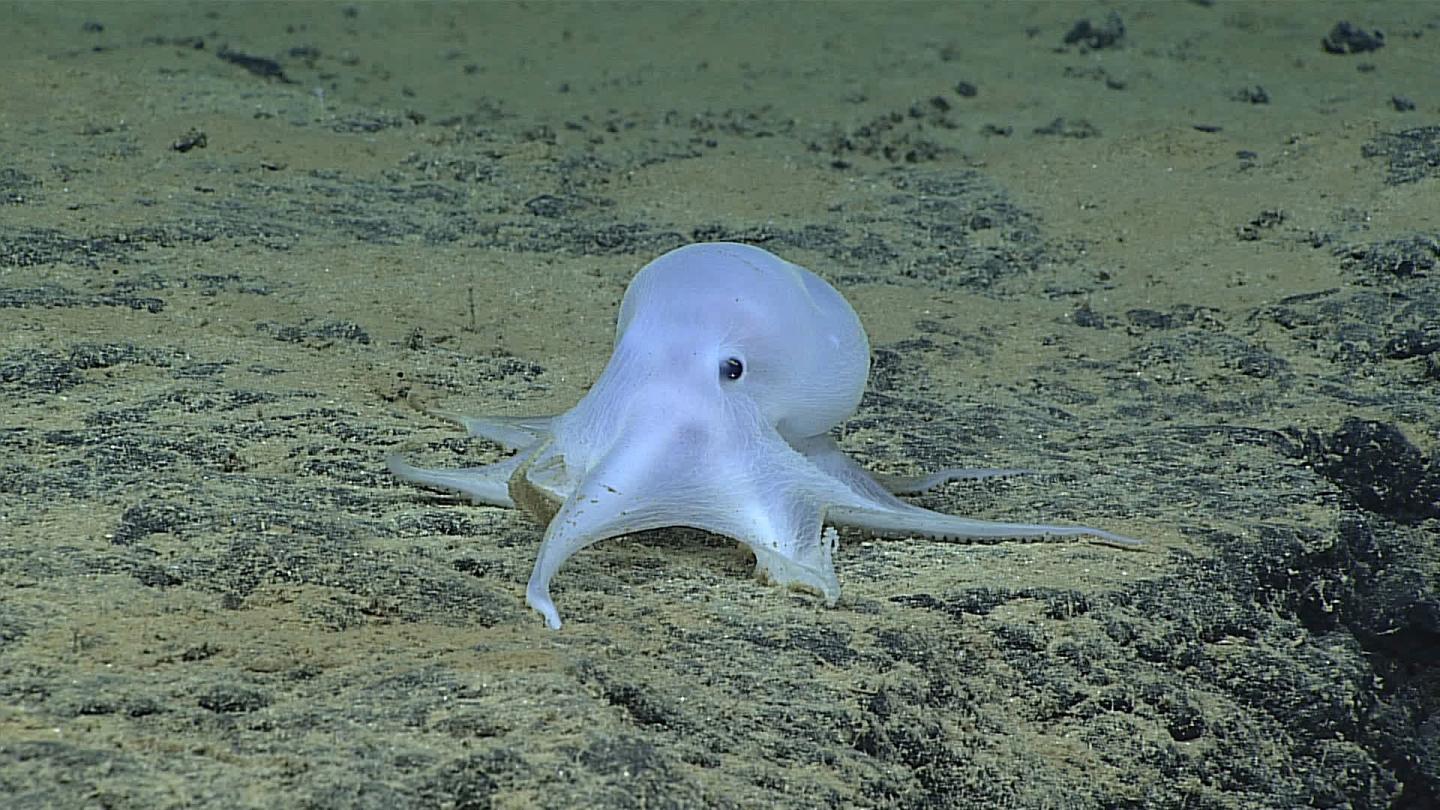
Credit: Courtesy of NOAA Office of Ocean Exploration and Research, Hohonu Moana 2016.
Last spring, researchers made headlines with the discovery of what was surely a new species of octopod, crawling along the seafloor at a record-breaking ocean depth of more than 4,000 meters (about 2.5 miles) off Necker Island near Hawaii. The octopod's colorless and squishy appearance immediately inspired the nickname "Casper." Now, a report published in Current Biology on December 19 reveals that these ghost-like, deep-sea octopods lay their eggs on the dead stalks of sponges attached to seafloor nodules rich in the increasingly valuable metals used in cell phones and computers.
"Presumably, the female octopod then broods these eggs, probably for as long as it takes until they hatch–which may be a number of years," says Autun Purser of the Alfred Wegener Institute's Helmholtz Centre for Polar and Marine Research in Germany.
"The brooding observation is important as these sponges only grow in some areas on small, hard nodules or rocky crusts of interest to mining companies because of the metal they contain," including manganese, he adds. "The removal of these nodules may therefore put the lifecycle of these octopods at risk."
Purser explains that the deep-sea manganese nodules form similarly to pearls in an oyster. In a process that could take millions of years, metals gradually build up in rocky layers onto a small starting seed, perhaps a shell fragment or a shark's tooth.
"These nodules look a bit like a potato, and are made up of rings of different shells of metal-rich layers," Purser says. "They are interesting to companies as many of the metals contained are 'high-tech' metals, useful in producing mobile phones and other modern computing equipment, and most of the land sources of these metals have already been found and are becoming more expensive to buy."
Purser says that little was known about the creatures found in the deep-sea environments where those attractive metals are found. In a series of recent cruises, the researchers set out to find the organisms that live there and to understand how the ecosystem and animals might be impacted by mining activities.
Their studies have shown that octopods are numerous in manganese crust areas, precisely where miners would hope to extract metals of interest. The mineral-biota association that they observed is a first for any octopod lacking fins (a group known as incirrate octopods), and it puts these captivating octopods, which live their long lives at a slow pace, at particular risk.
"As long-lived creatures, recovery will take a long time and may not be possible if all the hard seafloor is removed," Purser says. "This would be a great loss to biodiversity in the deep sea and may also have important knock on effects. Octopods are sizable creatures, which eat a lot of other smaller creatures, so if the octopods are removed, the other populations will change in difficult to predict ways."
Purser says that he and his colleagues continue to study the nodules and their importance to microbes and animals both small and large, including starfish, crabs, and fish.
###
This work was financially supported by the "Managing Impacts of Deep-seA reSource exploitation (MIDAS)" project funded by the European Union Seventh Framework Programme.
Current Biology, Purser et al.: "Association of deep-sea incirrate octopods with manganese crusts and nodule fields in the Pacific Ocean" http://www.cell.com/current-biology/fulltext/S0960-9822(16)31286-6.
Current Biology (@CurrentBiology), published by Cell Press, is a bimonthly journal that features papers across all areas of biology. Current Biology strives to foster communication across fields of biology, both by publishing important findings of general interest and through highly accessible front matter for non-specialists. Visit: http://www.cell.com/current-biology. To receive Cell Press media alerts, contact [email protected].
Media Contact
Joseph Caputo
[email protected]
617-397-2802
@CellPressNews
http://www.cellpress.com
############
Story Source: Materials provided by Scienmag





